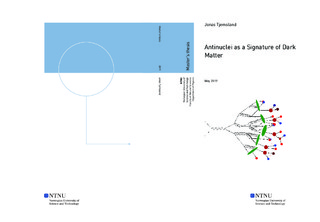| dc.contributor.advisor | Kachelriess, Michael | |
| dc.contributor.author | Tjemsland, Jonas | |
| dc.date.accessioned | 2019-08-25T14:01:59Z | |
| dc.date.available | 2019-08-25T14:01:59Z | |
| dc.date.issued | 2019 | |
| dc.identifier.uri | http://hdl.handle.net/11250/2610773 | |
| dc.description.abstract | Antideuteron og antihelium er blitt foreslått som en deteksjonskanal for spalting og annihilasjon av mørk materie i Melkeveien på grunn av en forventet lav astrofysisk bakgrunnstøy. I dag er det vanlig å bruke en standard partikkelvekstmodell per hendelse i en Monte Carlo simulering når antinukleussignalet fra både den mørke materien og bakgrunnsstøyen estimeres. Imidlertid mangler denne modellen et mikrofysisk bilde og har vist seg å ikke beskrive de siste produksjonsspekterene av antideuteron i proton-proton-kollisjoner godt. Her utvikler vi en ny partikkelvekstmodell for deuteron, helium-3, tritium og deres antinukleuser som er basert på å beskrive tilstanden til de produserte nukleusene som Wigner-funksjoner. Denne tilnærmingen gjør det mulig å inkludere både størrelsen på formasjonsregionen, som er prosessavhengig, og impulskorrelasjoner i et semi-klassisk bilde. Modellen inneholder en enkelt universell parameter som er fastsatt ved å tilpasse modellen til produksjonsspekterene av antideuteroner i proton-proton-kollisjoner. Denne verdien beskriver deretter bra produksjonen av antideuteron i elektron-positron-annihilasjoner og antihelium-3 i proton-proton-kollisjoner. Den nye partikkelvekstmodellen blir deretter benyttet på antideuteron- og antihelium-3-produksjon i annihalasjon av mørk materie og sekundær bakgrunnsstøy i galaksen. Den nye modellen gir på det meste en faktor 2--3 høyere fluks sammenlignet med den gamle modellen, som igjen er lite sammenlignet med usikkerhetene knyttet til nukleusenes forplantning gjennom galaksen. | |
| dc.description.abstract | Antideuteron and antihelium have been proposed as a detection channel for dark matter annihilation and decay in the Milky Way due to the low expected astrophysical background. Today it is common to use a coalescence model on an event-by-event basis in a Monte Carlo framework when estimating the antinucleus signal for both various dark matter models and the astrophysical background. However, this model lacks a microphysical picture and has been shown to not fit recent production spectra of antideuterons in proton-proton collisions well. Here we develop a new coalescence model for deuteron, helium-3, tritium and their antinuclei based on the Wigner function representations of the produced nuclei states. This approach includes both the size of the formation region, which is process dependent, and momentum correlations in a semi-classical picture. The model contains a single, universal parameter which is fixed by fitting the model to the production spectra of antideuterons in proton-proton interactions. Using this value, the model describes well the production of antideuteron in electron-positron annihilations and antihelium-3 in proton-proton collisions. The new coalescence model is in turn applied on the antideuteron and antihelium-3 production in dark matter annihilations and the secondary background in the Galaxy. The flux estimated using the new model differs at most by a factor 2--3 compared to the old model, which is small compared to the uncertainties related to the propagation through the Galaxy. | |
| dc.language | eng | |
| dc.publisher | NTNU | |
| dc.title | Antinuclei as a Signature of Dark Matter | |
| dc.type | Master thesis | |
